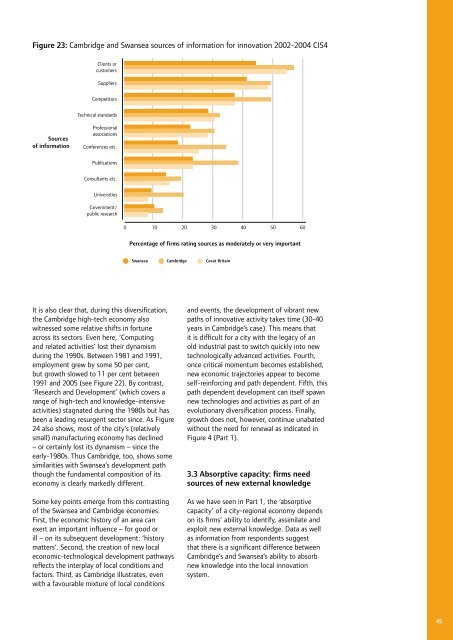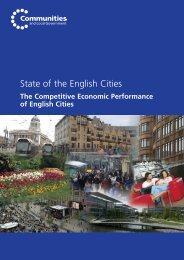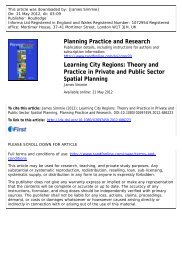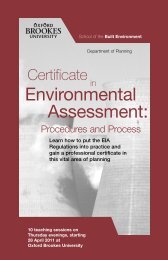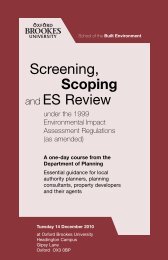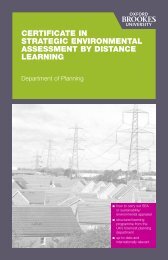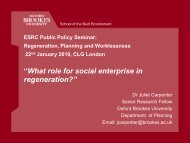History Matters: Path dependence and innovation in British city ...
History Matters: Path dependence and innovation in British city ...
History Matters: Path dependence and innovation in British city ...
Create successful ePaper yourself
Turn your PDF publications into a flip-book with our unique Google optimized e-Paper software.
Figure 23: Cambridge <strong>and</strong> Swansea sources of <strong>in</strong>formation for <strong><strong>in</strong>novation</strong> 2002-2004 CIS4<br />
Clients or<br />
customers<br />
Suppliers<br />
Competitors<br />
Technical st<strong>and</strong>ards<br />
Sources<br />
of <strong>in</strong>formation<br />
Professional<br />
associations<br />
Conferences etc.<br />
Publications<br />
Consultants etc.<br />
Universities<br />
Government/<br />
public research<br />
0 10 20 30 40<br />
50 60<br />
Percentage of firms rat<strong>in</strong>g sources as moderately or very important<br />
Swansea<br />
Cambridge<br />
Great Brita<strong>in</strong><br />
It is also clear that, dur<strong>in</strong>g this diversification,<br />
the Cambridge high-tech economy also<br />
witnessed some relative shifts <strong>in</strong> fortune<br />
across its sectors. Even here, ‘Comput<strong>in</strong>g<br />
<strong>and</strong> related activities’ lost their dynamism<br />
dur<strong>in</strong>g the 1990s. Between 1981 <strong>and</strong> 1991,<br />
employment grew by some 50 per cent,<br />
but growth slowed to 11 per cent between<br />
1991 <strong>and</strong> 2005 (see Figure 22). By contrast,<br />
‘Research <strong>and</strong> Development’ (which covers a<br />
range of high-tech <strong>and</strong> knowledge-<strong>in</strong>tensive<br />
activities) stagnated dur<strong>in</strong>g the 1980s but has<br />
been a lead<strong>in</strong>g resurgent sector s<strong>in</strong>ce. As Figure<br />
24 also shows, most of the <strong>city</strong>’s (relatively<br />
small) manufactur<strong>in</strong>g economy has decl<strong>in</strong>ed<br />
– or certa<strong>in</strong>ly lost its dynamism – s<strong>in</strong>ce the<br />
early-1980s. Thus Cambridge, too, shows some<br />
similarities with Swansea’s development path<br />
though the fundamental composition of its<br />
economy is clearly markedly different.<br />
Some key po<strong>in</strong>ts emerge from this contrast<strong>in</strong>g<br />
of the Swansea <strong>and</strong> Cambridge economies.<br />
First, the economic history of an area can<br />
exert an important <strong>in</strong>fluence – for good or<br />
ill – on its subsequent development: ‘history<br />
matters’. Second, the creation of new local<br />
economic-technological development pathways<br />
reflects the <strong>in</strong>terplay of local conditions <strong>and</strong><br />
factors. Third, as Cambridge illustrates, even<br />
with a favourable mixture of local conditions<br />
<strong>and</strong> events, the development of vibrant new<br />
paths of <strong>in</strong>novative activity takes time (30-40<br />
years <strong>in</strong> Cambridge’s case). This means that<br />
it is difficult for a <strong>city</strong> with the legacy of an<br />
old <strong>in</strong>dustrial past to switch quickly <strong>in</strong>to new<br />
technologically advanced activities. Fourth,<br />
once critical momentum becomes established,<br />
new economic trajectories appear to become<br />
self-re<strong>in</strong>forc<strong>in</strong>g <strong>and</strong> path dependent. Fifth, this<br />
path dependent development can itself spawn<br />
new technologies <strong>and</strong> activities as part of an<br />
evolutionary diversification process. F<strong>in</strong>ally,<br />
growth does not, however, cont<strong>in</strong>ue unabated<br />
without the need for renewal as <strong>in</strong>dicated <strong>in</strong><br />
Figure 4 (Part 1).<br />
3.3 Absorptive capa<strong>city</strong>: firms need<br />
sources of new external knowledge<br />
As we have seen <strong>in</strong> Part 1, the ‘absorptive<br />
capa<strong>city</strong>’ of a <strong>city</strong>-regional economy depends<br />
on its firms’ ability to identify, assimilate <strong>and</strong><br />
exploit new external knowledge. Data as well<br />
as <strong>in</strong>formation from respondents suggest<br />
that there is a significant difference between<br />
Cambridge’s <strong>and</strong> Swansea’s ability to absorb<br />
new knowledge <strong>in</strong>to the local <strong><strong>in</strong>novation</strong><br />
system.<br />
45


